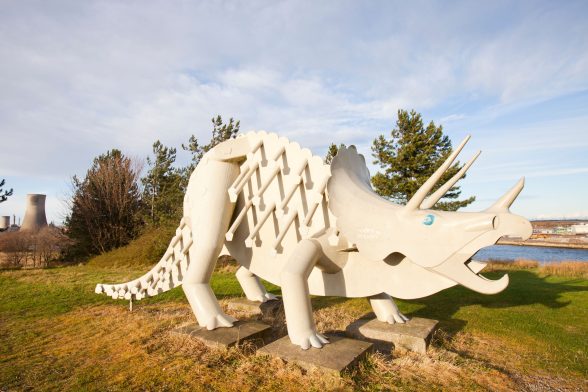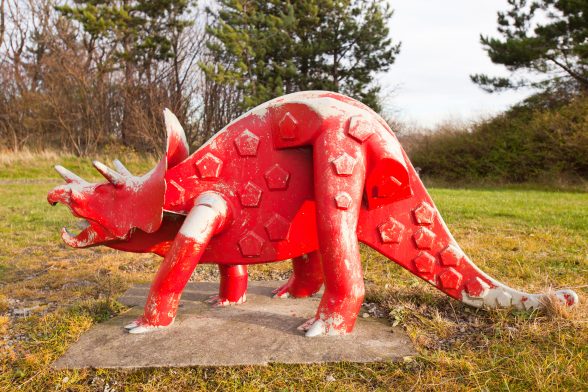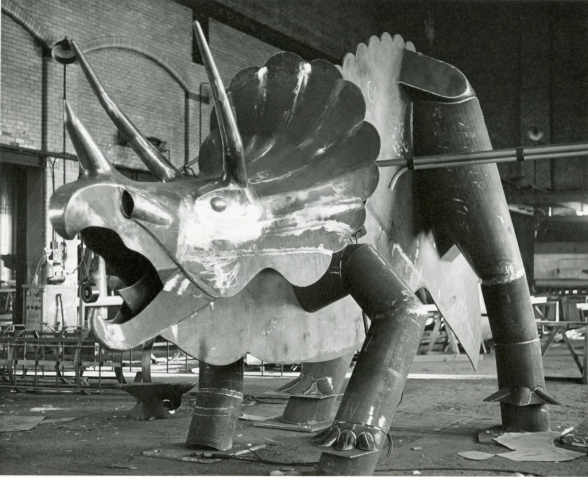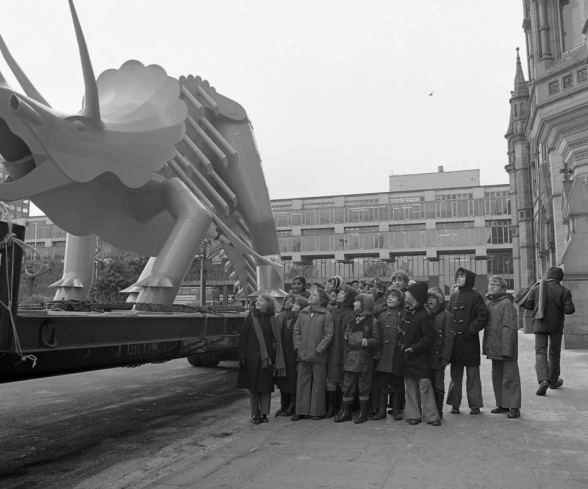This website uses cookies
This website uses cookies to enable it to function properly and to analyse how the website is used. Please click 'Close' to accept and continue using the website.



Image credit: Ashley Cooper pics
C20 Society has applied to list three industrial-style dinosaur sculptures at Teessaurus Park in Middlesbrough, in response to a threat to relocate the site-specific works. The sculptures were part of a competition-winning landscape regeneration scheme by artist Geneviève Glatt (1936-). Installed in 1979, they were designed to provide a safe place for children to play and represent a rare major 20th-century public art commission for a female artist.
A draft local plan issued by Middlesbrough Council in January 2024, outlined its intention to close-off half the park and potentially remove the sculptures, either to be re-sited within the park or at an alternative location. Listing would ensure that proper consideration is given to the conservation of these important artworks when developing proposals for the riverside park site.

Image credit: Ashley Cooper pics
From wasteland to riverside park
In the late 19th and early 20th century, the site of what is now Teessaurus Park was a thriving industrial centre for the production of iron and steel, known as ‘Ironmasters District’. From the 1930s onwards, companies like Dorman Long and others gradually began to relocate elsewhere, leaving behind an industrial wasteland on the banks of the River Tees.
In 1974 the Arts Council launched an initiative called ‘Art Into Landscape’, encouraging members of the public to submit proposals to enliven under-used public spaces for benefit of their communities. Organised in collaboration with the RIBA, The Landscape Institute, and The Sunday Times, the judges selected 12 sites which were offered by local authorities throughout Britain.
A local designer called Geneviève Glatt submitted an entry for Middlesbrough’s Ironworks District site with a proposal for a ‘Teessaurus Playground’, which would be populated by dinosaur sculptures and be a safe place for children to play. In her competition entry, Glatt added “The site needs life – forms sympathetic to the environment but large and powerful enough to compete with surrounding structures. Monsters…? Dinosaurs came to mind“.
Her submission was picked by the judges – this selection panel included the artist Mark Boyle, architect and town-planner Lord Esher (Lionel Brett), architectural critic Ian Nairn, architect David Rock and landscape architect Tony Southard. The winning designs were exhibited at the Serpentine Gallery, with grants then awarded by the Arts Council to carry out the selected landscape improvement projects.

Image from the John Buchan photo collection (Ref: ACC- 7224), courtesy of Teesside Archives.
Glatt created three dinosaur sculptures, which she arranged on the summit of a re-landscaped mound of slag: a full-grown triceratops (measuring 30ft by 13ft) and two young triceratops, which were fabricated in steel by the Stockton steel firm, T. Hart and Co. In press coverage at the time, Glatt “reckoned the life size prehistoric monsters would fit in well with the environment of the river, shipyards, industry and, in the background, the area’s other iron master, the Transporter Bridge [of 1911 – now Grade II* listed]”.
The adult triceratops was installed in February 1979 and the two baby triceratops followed later that year. Once in position, the surrounding area was landscaped and planted. The original plan was for 6 ‘monsters’, but cost limits meant only three were initially created. However, more dinosaurs were added in the late 1980s. These later dinosaurs are more simply depicted as skeletons rather than live animals like the originals. It is the Society’s view that Glatt’s original three are of the greatest historic and artistic interest, and are the focus of our listing application to Historic England.

Image courtesy of Teesside Archives (Photo reference: CC-N-C4162-1)
Geneviève Glatt
Geneviève Glatt (nee Goujon) was born in 1936 in Autun, France, moving to England after WWII where she became a nurse, before eventually studying Interior Design at Teesside Polytechnic, graduating in 1977. It was while Glatt was a student that she heard about the ‘Art Into Landscape’ competition. She entered, was selected as a ‘winner’, and travelled to the Serpentine Gallery in London to see her submission in an exhibition in July 1977. When it came to designing the sculptures, Glatt decided to collaborate with the architect Ron Farrell for his expertise and model-making skills. This was to be Glatt’s only major sculptural work – she later turned to crafts, focusing on weaving and crochet. The sculptures at Teessaurus Park have rarity value as a major public art project by a woman designer in this period.

Image credit: Bunk3r (Flickr)
Post-war public art
The Middlesbrough sculptures are an excellent example of Arts Council-funded community art, created to enliven a new public green space within the town, and stand up well against other listed post-war public sculptures. These were often commissioned to enhance new public realm, such as housing, schools, universities and civic set pieces. Animal sculptures already listed on the national register include The Bull, on the Alton Estate in London (1961 by Robert Clatworthy), the Wild boar sculpture (1969 by Elisabeth Frink) and the Donkey sculpture (1955 by Will Soukop), both in Harlow, Essex, and Gorilla at Crystal Palace Park in London (1961 by David Wynne).
The artworks also compare well to listed examples of post-war interactive sculpture and structures intended for play, such as the Play Sculpture in Curtis Gardens in Birmingham, created for children from nearby housing estates (c.1960 by the sculptor John Bridgman working in collaboration with the playground designer Mary Mitchell); the slide structure in the children’s playground at the Brunel Estate in Westminster, London (1973-74 by Michael Brown); and the William Mitchell concrete murals at Hockley Flyover in Birmingham (1968).
With thanks to North East Statues and the Glatt family for their helping in researching this case.

Become a C20 member today and help save our modern design heritage.